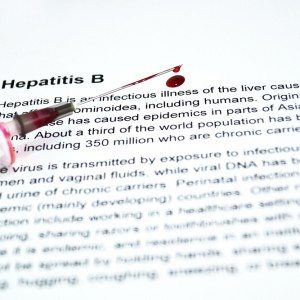 A recent study identified high levels of interleukin (IL)-23 in patients’ serum as a biomarker for chronic hepatitis B patients positive for hepatitis B e antigen (HBeAg) responding to pegylated interferon (PegIFN) therapy. The study entitled “The serum IL-23 level predicts the response to pegylated interferon therapy in patients with chronic hepatitis B” was published in the journal Liver International by Chengbo Yu, first author, and Dr. Lanjuan Li, senior author, from the State Key Laboratory for Diagnosis and Treatment of Infectious Disease, The First Affiliated Hospital, College of Medicine, Zhejiang University, China, and further colleagues.
A recent study identified high levels of interleukin (IL)-23 in patients’ serum as a biomarker for chronic hepatitis B patients positive for hepatitis B e antigen (HBeAg) responding to pegylated interferon (PegIFN) therapy. The study entitled “The serum IL-23 level predicts the response to pegylated interferon therapy in patients with chronic hepatitis B” was published in the journal Liver International by Chengbo Yu, first author, and Dr. Lanjuan Li, senior author, from the State Key Laboratory for Diagnosis and Treatment of Infectious Disease, The First Affiliated Hospital, College of Medicine, Zhejiang University, China, and further colleagues.
Hepatitis B virus (HBV) infections cause 1 million deaths worldwide per year. Antiviral therapy is crucial to improving the prognoses of patients, with the three main aims in the antiviral therapy of chronic hepatitis B virus (HBV) infection being to obtain a virological response, undetectable levels of HBV DNA in the serum, and hepatitis B e antigen (HBeAg) seroconversion (HBeAg serological response). HBeAg persistence is an independent risk factor for hepatocellular carcinoma while HBeAg seroconversion is thought to be important for a benign prognosis.
In this study, the research team evaluated the potential use of interleukin (IL)-23 and IL-17 serum levels as indicators for anti-hepatitis B virus (HBV) therapy. They recruited 127 patients with chronic hepatitis B (CHB), 20 chronic asymptomatic HBV carriers (AsCs) and 32 healthy controls. Patients with CHB had baseline serum levels of IL-23 and IL-17 higher than in AsCs and healthy controls. The CHB patients were treated with pegylated interferon (PegIFN) therapy. CHB patients with high levels of IL-23 and IL-17 before and during treatment had significant reductions in the levels of IL-23 and IL-17 achieved HBeAg elimination or a decrease in HBsAg >1 log10 IU/ml when compared with patients that were persistently HBeAg-positive or had a decrease in HBsAg <1 log10 IU/ml. The researchers found that a high serum IL-23 level before treatment is a prognostic of therapeutic response in HBeAg-positive CHB patients during PegIFN therapy.
“This distinction can help clinicians encourage patients with a high probability to continue with their current regimen and to modify the regimen earlier for patients with a low probability of response,” wrote the authors in the journal Liver International, where the study is now published.
The authors noted that response to PegIFN can be lower due to adverse effects but if patients are convinced that they will probably respond well to treatment, this can potentiate patient agreement and thus achieve a higher therapeutic response.
The researchers propose using baseline serum levels of IL-23 together with on-treatment HBsAg changes to identify patients with a high and low likelihood of response.

